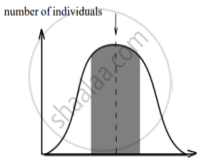Advertisements
Advertisements
Question
The graphs below show three types of natural selection. The shaded areas marked with arrows show the individuals in the population who are not selected. The dotted vertical lines show the statistical means.
 |
 |
 |
| character Graph A |
character Graph B |
character Graph C |
- What names are given to the types of selection shown in graphs A, B and C?
- After the selection has operated for several generations in the above populations indicated as, Graph A, B and C, graphically illustrate the probable results.
Solution
- A - stabilising; B - directional; C - disruptive;
- Graph A - Stabilising
Graph B - Directional
Graph C - Disruptive
APPEARS IN
RELATED QUESTIONS
What does the following equation represent? Explain.
p2 + 2pq + q2 = 1
With the help of an algebraic equation, how did Hardy-Weinberg explain that in a given population the frequency of occurrence of alleles of a gene is supposed to remain the same through generations?
What is the Founder's effect?
In the Hardy-Weinberg equilibrium equation, the homozygous mutant is represented as ______.
Hardy Weinberg's principle explains ______
Hardy - Weinberg equilibrium is known to be affected by gene - flow, genetic drift, mutation, genetic recombination and
Explain Hardy-Weinberg's principle
Write Hardy Weinberg's equation.
A population of 200 fruit flies is in Hardy Weinberg equilibrium. The frequency of the allele (a) 0.4. Calculate the following:
Frequency of the allele (A).
A population of 200 fruit flies is in Hardy Weinberg equilibrium. The frequency of the allele (a) 0.4. Calculate the following:
The number of homozygous recessive fruit flies.
